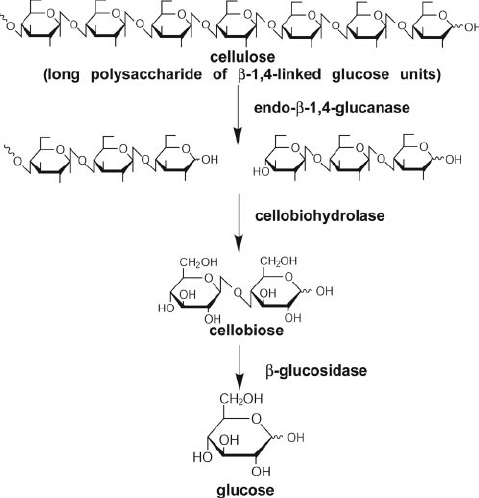
Cellulose decomposition:
- Cellulose is relatively resistant polysaccharide, found in cell wall of plant cell.
- Cellulose is a linear polymer of β-D-glucose in which glucose units are linked together by β-1,4-glycosidic bond.
- It is the most abundant organic matter found in nature. In plant it occurs in association with lignin and hemicellulose.
Mechanism of cellulose decomposition:
- Pathway of cellulose decomposition follows series of enzymatic reactions.
- Enzymes responsible for cellulose decomposition is cellulase.
- Cellulase is a complex of three enzymes (ie. C1 enzyme, β-1,4-glucanase and β-1,4-glucosidase).
- Series of enzymatic reaction occurs outside the microbial cell in which complex cellulose is decomposed into free glucose molecules by extracellular enzymes.

Step I: hydrolysis by C1 enzymes:
- C1 enzyme hydrolyses native cellulose polymer to form smaller fragments.
- C1 enzyme is only found in true cellulolytic microorganisms.
Step II: hydrolysis by β-1,4-glucanase enzyme:
- β-1,4-glucanase hydrolyze the smaller fragments of cellulose to form even smaller fragments such as disaccharides, tri-saccharides etc.
- There are two types of glucanase ie. Endo-glucanase and Exo-glucanase.
- Endo-glucanase randomly cuts the fragments somewhere in the middle whereas exo-glucanase sequentially release glucose molecule from one end of the fragment.
- Some free glucose unit as well as disaccharides, tri-saccharides and other oligosaccharides are produced by the action of β-1,4-glucanase.
Step III: hydrolysis by β-1,4-glucosidase enzyme:
- β-1,4-glucosidase hydrolyses di, tri and oligosaccharides to form free glucose molecules.
Step IV: metabolism of glucose:
- Free glucose molecules then enter into microbial cell and metabolized by glycolysis to form pyruvate.
- Depending upon types of microorganisms and the condition of environment, pyruvate is converted into CO2 and water or ethanol or any organic acids
Examples of Cellulolytic microorganisms; Cellulose decomposers
- Bacteria: Bacillus, Cellulomonas, Clostridium, Cytophaga, Polyangium, Pseudomonas etc
- Fungi: Aspergillus, Alterneria, Fomes, Fusarium, Myrothecium etc
- Actinomycetes: Micromonospora, Nocardia, Streptomyces, Streptosporangium etc.
Factors affecting cellulose decomposition in soil:
- Various environmental and other factors affects rate of cellulose decomposition in soil by microorgansims, some of them are;
- i. Addition of available Nitrogen:
- Additionof inorganic nitrogen compounds such as ammonia, nitrite or easily decomposable nitrogen compounds like aminoacids and proteins increase the rate of cellulose decomposition by microorganisms.
- Microorganisms require both carbon and nitrogen for biosynthesis of their cellular materials. Therefore, microbial decomposition of cellulose cannot occurs without nitrogenous sources.
- ii. Temperature:
- Cellulose decomposition can occurs from temperature near freezing to above 65°C because both psychrophiles and thermophiles are involved in cellulose degradation.
- But rate of cellulose decomposition is maximum in mesophilic range of temperature of 25-30°C because most cellulolytic microbes are mesophiles.
- iii. Aeration:
- In anaerobic soil, anaerobic bacteria like Clostridium decompose cellulose and in aerobic soli mainly fungi and aerobic bacteria take part in decomposition of cellulose.
- Rate of cellulose is higher in aerobic soil.
- iv. Moisture:
- Excessive moisture brings anaerobic condition in soil. Therefore, rate of cellulose decomposition is slower in water logged soil.
- v. pH:
- In neutral to alkaline soil, bacteria and actinomycetes mainly take part in cellulose decomposition.
- In acidic soil, fungi are dominant cellulose decomposers.
- Rate of cellulose decomposition is slightly higher in acidic soil than alkaline and neutral.
- vi. Addition of organic matter:
- Addition of easily decomposable organic matters increase the rate of cellulose decomposition.
- If only cellulose is present in soil, microorganisms cannot multiply fast so that the rate of decomposition become slower.
- If small amount of easily decomposable organic matter is added initially in soil, microorganisms rapidly multiplies and grow their numbers. Furthermore cellulose is degraded rapidly when the easily decomposable organic matter is exhausted.
- vii. Lignin:
- Lignin slows the rate of cellulose decomposition.
- Lignin itself is not toxic to cellulolytic microbes. Inhibition of cellulose decomposition by lignin is due to its close association to cellulose in cell wall.
